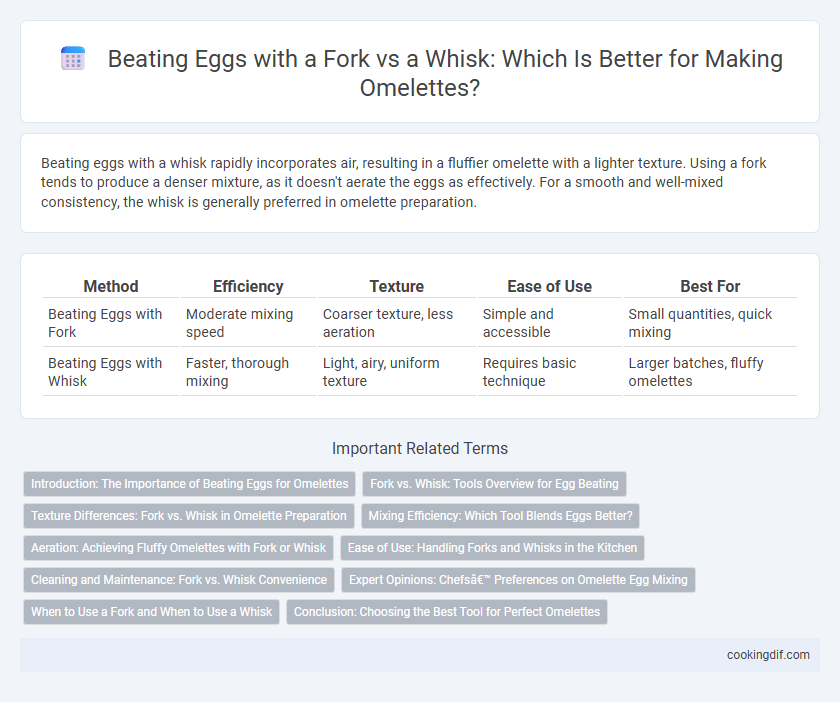Beating eggs with a whisk rapidly incorporates air, resulting in a fluffier omelette with a lighter texture. Using a fork tends to produce a denser mixture, as it doesn't aerate the eggs as effectively. For a smooth and well-mixed consistency, the whisk is generally preferred in omelette preparation.
Table of Comparison
| Method | Efficiency | Texture | Ease of Use | Best For |
|---|---|---|---|---|
| Beating Eggs with Fork | Moderate mixing speed | Coarser texture, less aeration | Simple and accessible | Small quantities, quick mixing |
| Beating Eggs with Whisk | Faster, thorough mixing | Light, airy, uniform texture | Requires basic technique | Larger batches, fluffy omelettes |
Introduction: The Importance of Beating Eggs for Omelettes
Beating eggs thoroughly is essential for achieving the ideal omelette texture, as it aerates the mixture for fluffiness and ensures even cooking. Using a whisk incorporates more air than a fork, creating a lighter, more tender omelette, while a fork offers more control for gentle mixing and slightly denser results. Choosing the right tool impacts the egg's consistency, ultimately influencing the final taste and presentation of the omelette.
Fork vs. Whisk: Tools Overview for Egg Beating
Using a fork for beating eggs provides a quick and simple method ideal for small quantities, effectively breaking yolks and combining them with whites, while a whisk offers superior aeration and smoother texture essential for fluffy omelettes. Forks create a less uniform mixture with larger bubbles, whereas whisks incorporate more air, resulting in a lighter, more evenly mixed batter. Professional chefs typically prefer whisks for their ability to produce consistent results and enhance the omelette's volume and tenderness.
Texture Differences: Fork vs. Whisk in Omelette Preparation
Beating eggs with a fork produces a coarser mixture, resulting in a denser, slightly uneven omelette texture with visible strands of egg white. Using a whisk incorporates more air, yielding a lighter, fluffier omelette with a smoother consistency and uniform rise. The choice between fork and whisk directly influences the final texture and mouthfeel of the prepared omelette.
Mixing Efficiency: Which Tool Blends Eggs Better?
Beating eggs with a whisk creates a smoother and more consistent mixture due to its multiple tines, which aerate the eggs more efficiently. A fork can be effective for lightly mixed eggs but often results in a less uniform texture, impacting the overall fluffiness of an omelette. For optimal mixing efficiency and better incorporation of air, a whisk is the preferred tool over a fork.
Aeration: Achieving Fluffy Omelettes with Fork or Whisk
Beating eggs with a whisk incorporates more air, resulting in greater aeration and a fluffier omelette texture compared to using a fork. The whisk's multiple tines create rapid air bubbles, enhancing volume and lightness in the mixture. Forks, while effective for mixing, produce denser eggs with less aeration, yielding a heavier omelette.
Ease of Use: Handling Forks and Whisks in the Kitchen
Beating eggs with a fork offers simplicity and control, making it ideal for quick, small batches or for cooks who prefer minimal kitchen tools. Whisks enhance aeration and create a uniform mixture, but their bulkier design can be less maneuverable in tight bowls or limited spaces. Forks provide better precision and ease when mixing in compact containers, whereas whisks excel in efficiently incorporating air for fluffier omelettes.
Cleaning and Maintenance: Fork vs. Whisk Convenience
Using a fork to beat eggs offers easier cleaning and lower maintenance due to its simple design and fewer crevices where food can get trapped. In contrast, a whisk's multiple wires often require more thorough scrubbing and longer drying times to prevent rust or residue buildup. Choosing a fork enhances convenience, especially for quick cleanup after preparing an omelette.
Expert Opinions: Chefs’ Preferences on Omelette Egg Mixing
Chefs often prefer beating eggs with a whisk over a fork for making omelettes due to the whisk's ability to incorporate more air, resulting in a fluffier texture. Expert culinary opinions highlight that a whisk provides more consistent mixing, evenly blending the yolks and whites, which is crucial for a smooth, homogenous batter. While a fork can suffice for quick mixing, professional chefs emphasize that the whisk's design enhances egg aeration, improving the final omelette's volume and tenderness.
When to Use a Fork and When to Use a Whisk
Use a fork to beat eggs when preparing small quantities or for quick mixing in omelette recipes needing minimal aeration, preserving a denser texture. A whisk is ideal for larger batches or when creating a fluffy, airy omelette as it incorporates more air into the eggs, enhancing volume and lightness. Selecting the right tool depends on desired omelette texture and preparation time.
Conclusion: Choosing the Best Tool for Perfect Omelettes
Beating eggs with a whisk incorporates more air, resulting in a fluffier omelette with a light texture, while using a fork offers better control for mixing small batches and can prevent over-beating. Professional chefs often prefer a whisk for consistent aeration and smoothness, enhancing the overall rise and tenderness of the final omelette. Ultimately, selecting a whisk or fork depends on the desired texture and quantity, with a whisk best suited for fluffy, airy omelettes and a fork ideal for quick, simple mixing.
Beating Eggs with Fork vs Beating Eggs with Whisk for mixing Infographic

 cookingdif.com
cookingdif.com